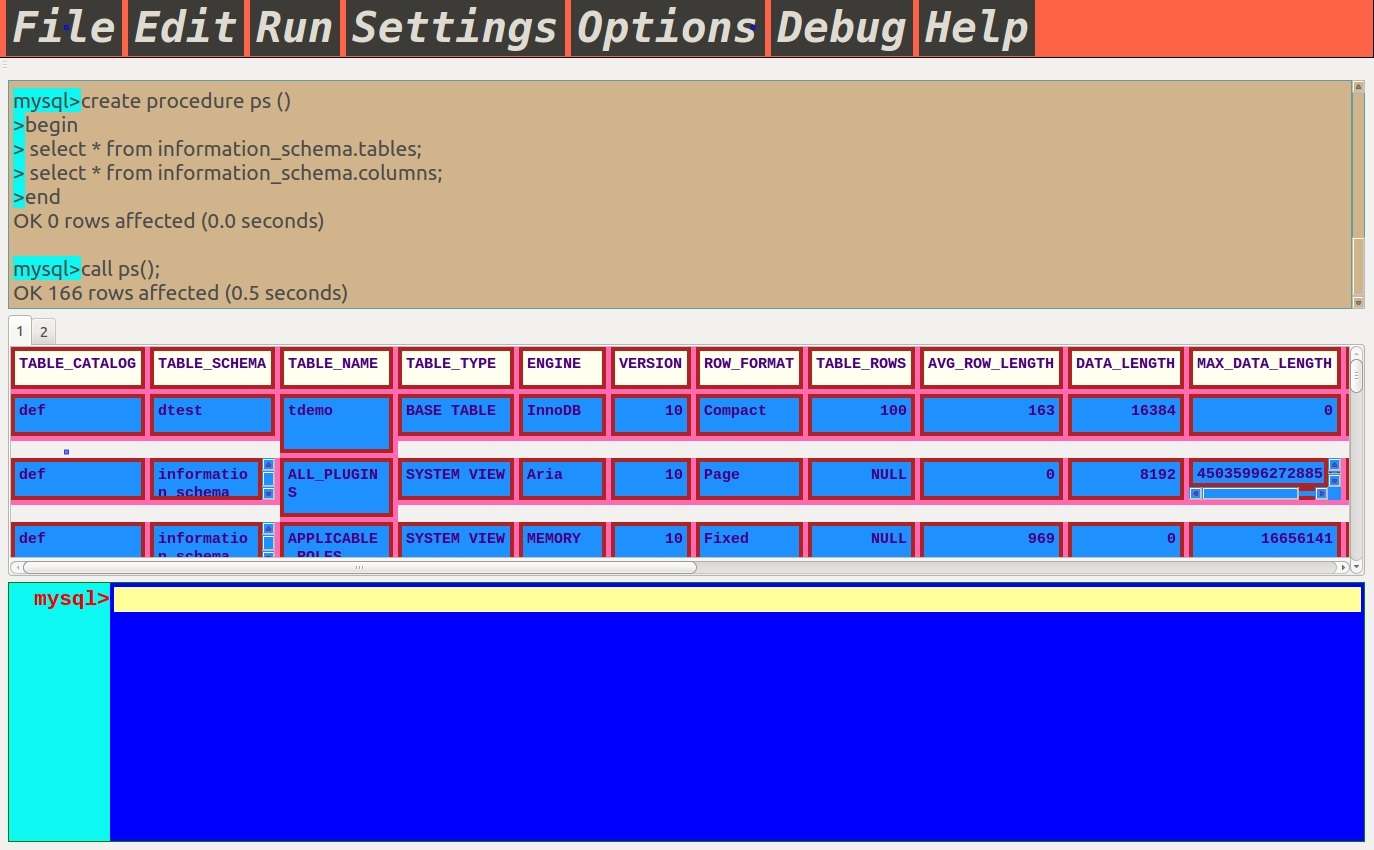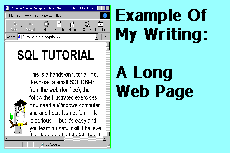
Company Info
Download
Peter Gulutzan's blog
screenshots
Books by employees
Glossary
Home

OCELOT COMPUTER SERVICES INC.
Peter Gulutzan and Trudy Pelzer founded Ocelot Computer Services Inc. in 1981.
Ocelot produced the first DBMS for the MS-DOS operating system (it was called 86-DOS in those days, that was before Microsoft bought their operating system from SCP). We originally specialized in libraries, we are the original producers of the Ocelot Library System, and much of our income came indirectly from schools and public libraries worldwide. We converted to SQL shortly before the SQL-89 standard came out, and our older SQL-89 DBMS, OCELOT2 - THE SQL!, was a secret component of several packages for a variety of industries. This DBMS can still be downloaded from elsewhere on this site, but has not been updated since 2003.
Ocelot experts wrote the standard reference text for SQL: SQL-99 Complete, Really by Peter Gulutzan and Trudy Pelzer, ISBN 0-87930-568-1. Check the user reviews on amazon.com, or visit the book's errata page, or just look at the book -- it's available free online. Read Monty Widenius's comment about this development.
Ocelot experts also were responsible for the classic books that denuded SQL's secrets: Optimizing SQL (ISBN 0-13-100215-5) and its successor SQL Performance Tuning (ISBN 0-201-79169-2).
Ocelot employees have also written numerous articles for computer magazines/online journals, another book (Optimizing C with Assembly Code ISBN 0-87930-447-2), and have done considerable consulting and custom-programming work, specifically for SQL projects. We regard ourselves as experts in standard SQL, MySQL, and MariaDB.
Between 2003 and 2011, Peter and Trudy worked for MySQL AB which became part of Sun Microsystems which became part of Oracle. Subsequently they held positions at HP, and now they are back with Ocelot.
The company's current product is the Ocelot Graphical User Interface (ocelotgui) for MySQL and MariaDB.
Magazine Articles
Available on the web, by Peter Gulutzan:"Making programs go faster" -- assembly-language -- in Dr. Dobb's (January/1995)
"The Software Conspiracy" -- a book review -- in ercb (March/2000)
"Collations" -- how IBM DB2, Oracle and SQL Server sort -- in dbazine (May/2002)
"Transaction Logs" -- how ARIES works -- in dbazine (July/2002)
"How Logs Work On MySQL With InnoDB Tables" -- information gleaned by reading source code -- in devarticles (August/2002)
"Standard SQL" -- how IBM DB2, Oracle and SQL Server support the SQL Standard -- and how they don't -- in dbazine (August/2002)
"Sequences and Identity Columns" -- a discussion of the support provided for sequences or identity columns by IBM DB2, Oracle and SQL Server -- in dbazine (October/2002)
"SQL Naming Conventions" -- a survey of the common naming conventions in IBM DB2, Oracle and SQL Server -- in dbazine (November/2002)
"Locks" -- how IBM DB2, Oracle and SQL Server use locks to control concurrent jobs -- in dbazine (January/2003)
"SQL Views Transformed" -- how IBM DB2, Oracle and SQL Server handle views -- in dbazine (March/2003)
"The Character Sets of Version 4.1" -- a description of the major features ("many character sets per database / per server / per table", "many collations per character set", "Unicode") added to MySQL's support for character sets and collations in release 4.1 -- in the MySQL Newsletter, written with Alexander Barkov of MySQL (April/2003)
"Who Works for MySQL?" -- a description of MySQL's unique business model -- in the MySQL Newletter (October/2003)
-- how to research MySQL internals by reading the documentation -- in the MySQL Newsletter (November/2003)
"How to Study MySQL Internals II" -- provides information on articles and other content that can be used to study MySQL internals -- in the MySQL Newsletter (December/2003)
"Stored Procedures in MySQL" -- a description of MySQL's support for stored procedures, available with release 5.0 -- in the MySQL Newsletter (January/2004)
"Ein Join ist nicht genug SQL-Unterabfragen verwenden" -- for German speakers interested in MySQL's subquery implementation, a copy of the article that appeared in iX Magazin, June/2004)
"Views Work in MySQL 5.0" -- a description of MySQL 5.0's support for views -- in Database Journal (August/2004)
"The Full-Text Stuff That We Didn't Put In The Manual" -- what's going on with full-text searching in MySQL version 4.1.2-- in the MySQL Developer Zone (August/2004)
"MySQL Triggers Tryout" -- a description of MySQL 5.0's support for triggers -- in O'Reilly's ONLamp.com (February/2005)
"MySQL Stored Procedures" -- a 98-page book with many exercises and examples
"MySQL 5.0 New Features: Triggers" -- a description of MySQL 5.0's support for triggers -- in the MySQL Developer Zone (March/2005)
"MySQL's Full-Text Formulas" -- a discussion of the fulltext formulas used by MySQL; includes a helpful program -- in Database Journal (June/2005)
Also on the web, by Peter Gulutzan and Trudy Pelzer:
"The Oracle Calendar" -- how Oracle handles dates -- in an "Oracle FAQ site" (January/2003)
"SQL Server's DATETIME Data Type" -- how Microsoft SQL Server handles dates -- in ITtoolbox (January/2003)
"DB2's DATE data type" -- how IBM DB2 handles dates -- in Searchdatabase's tip site (January/2003)
"Dates in SQL" -- the DATE data type and its impact on eight SQL DBMSs -- in InformIT (February/2003)
"So You Want an IOT" -- a discussion of index-organized tables vs heap-organized tables -- in dbazine (March/2003)
Available on the web, by Trudy Pelzer:
"Windows 2000 Systems Programming Black Book" by Al Williams -- a book review -- in ercb i.e. Dr. Dobb's (January/2001)
"The Hundredth Window: Protecting Your Privacy and Security in the Age of the Internet" by Charles Jennings and Lori Fena -- a book review -- in ercb (January/2001)
"Picture This: BLOBs" -- BLOB support with IBM DB2, Oracle and SQL Server -- in dbazine (April/2003)
"Timestamps" -- how the TIMESTAMP/DATETIME data types work with IBM DB2, Oracle and SQL Server -- in dbazine (June/2003)
"XML and the Big Three" -- a quick overview of how IBM DB2, Oracle and SQL Server can handle the transformation between XML and DBMS data -- in dbazine (July/2003)
"System Tables" -- how to retrieve metadata information with IBM DB2, Oracle and SQL Server -- in dbazine (October/2003)
"Temporal Functionality" -- describes the new functionality for DATE/TIME/DATETIME/TIMESTAMP values added to MySQL in version 4.1 -- in the MySQL Developer Zone (October/2004)
"Structure Means Subqueries: Nesting SELECTs in MySQL 4.1" -- describes the way MySQL supports subqueries -- in the MySQL Developer Zone (November/2004)
"New in 4.1: All the Little Features" -- describes a host of minor new features added to MySQL version 4.1 that may be just what you're looking for -- in the MySQL Developer Zone, written with Jim Winstead of MySQL (November/2004)
"MySQL 5.0 New Features: Data Dictionary" -- a description of MySQL 5.0's support for the standard SQL INFORMATION_SCHEMA -- in the MySQL Developer Zone (March/2005)
"MySQL 5.0 New Features: Views" -- a description of MySQL 5.0's support for views -- in the MySQL Developer Zone (March/2005)
Print Media: available by asking the publisher, by Peter Gulutzan:
Comparing Characters -- for C programmers -- in Windows/DOS Developer's Journal (December/1991)
Programmer's Bookshelf -- a review of Zen of Code Optimization by Michael Abrash -- in Dr. Dobb's (January/1995)
ORG -- a tip for Intel processors -- in PC Techniques (Aug-Sept/1995)
MySQL 4.1 und Umlautsortierung: Deutsch tupeln -- for German speakers interested in MySQL's German-specific sort order options -- in iX Magazin (February/2004)
Ein Join ist nicht genug SQL-Unterabfragen verwenden -- for German speakers interested in MySQL's subquery implementation -- in iX Magazin (June/2004). This article is also available online, at iX Magazin's web site.
Blog postings
Peter maintained a blog at blogs.mysql.com. The original site is gone now but the wayback machine saved the posts. See the blog archive.
Books
by Peter Gulutzan and Trudy Pelzer:There are four books in all.
The latest book is SQL Performance Tuning which Addison-Wesley published on September 20 2002. It's a discussion of internals and issues for DB2, Informix, Ingres, InterBase, MySQL, Oracle, SQL Server, and Sybase. Click here to see the table of contents and early reviews.
Web pages
Click to see a tutorial with many pictures:
Copyright (c) 2002-2013 by Ocelot Computer Services Inc. All rights reserved.
Return to Ocelot home page
Send enquiries or suggestions to help@ocelot.ca